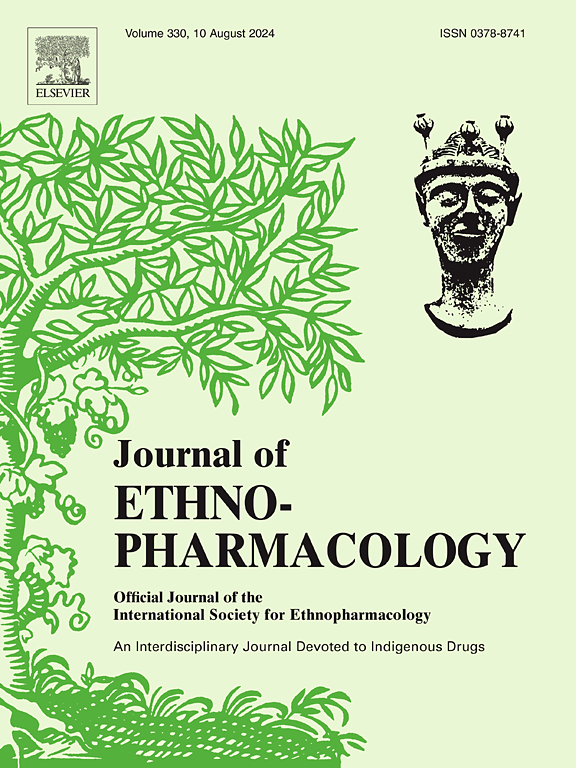人参皂苷Rg1通过抑制TRPC6-ChREBP-TXNIP信号通路减轻t2dm诱导的肾损伤和纤维化
IF 4.8
2区 医学
Q1 CHEMISTRY, MEDICINAL
引用次数: 0
摘要
人参作为一种中药,具有多种功效,包括调节血糖、血压等。人参皂苷Rg1是人参的主要活性成分,可显著改善2型糖尿病(T2DM)小鼠肾脏病理损伤。然而,Rg1在减轻T2DM中的作用和机制尚不完全清楚。本研究旨在探讨Rg1在T2DM肾损害及纤维化中的作用及其分子机制。材料与方法分别在小鼠和细胞上建立st2dm模型,并给予相应药物。用SA-β-Gal和油红O观察细胞衰老和脂滴沉积;采用H&;E、PAS观察肾脏病理变化;采用马松红、天狼星红评价肾纤维化程度。采用免疫组织化学、免疫荧光和免疫印迹法分析相关指标,检测体外和体内ROS水平。钙显像法检测[Ca2+]i水平。结果敲除rg1和Trpc6可显著改善肾功能障碍,减轻肾损伤和纤维化,降低Trpc6、CaN、TXNIP、ChREBP、p-ASK1和NLRP3炎症小体的表达水平。同时,敲除Rg1和Trpc6显著抑制线粒体损伤和凋亡蛋白释放。此外,Rg1治疗已被证明可显著减少T2DM的脂质沉积和ROS积累,而敲除Trpc6对这些参数没有影响。结论rg1治疗可抑制TRPC6-ChREBP-TXNIP通路,从而改善慢性t2dm所致肾损伤及纤维化。本文章由计算机程序翻译,如有差异,请以英文原文为准。

Ginsenoside Rg1 attenuates T2DM-induced renal damage and fibrosis by inhibiting TRPC6-ChREBP-TXNIP signaling
Ethnopharmacological relevance
As a traditional Chinese medicine, ginseng has many benefits, including regulating blood sugar, blood pressure and so on. Ginsenoside Rg1 is the main active component of ginseng and has been found to significantly improve renal pathological injury in type 2 diabetes mellitus (T2DM) mice. However, the effects and mechanisms of Rg1 in attenuating T2DM are not fully understood.
Aim of the study
This study aims to investigate the role of Rg1 in the treatment of renal damage and fibrosis induced by T2DM and its molecular mechanism.
Materials and methods
T2DM models were constructed on mice and cells respectively and were administered with corresponding drugs. SA-β-Gal and Oil Red O were used to observe cell senescence and lipid droplet deposition; H&E and PAS were used to observe pathological changes in the kidney; masson and sirius red were used to evaluate the level of renal fibrosis. Immunohistochemistry, immunofluorescence and Western blotting were performed to analyze the relevant indexes which resulted in the detection of ROS levels in vitro and in vivo. Calcium imaging was used to test the level of [Ca2+]i.
Results
Rg1 and Trpc6 knockout could significantly improve kidney dysfunction, attenuate renal injury and fibrosis and also decrease the expression levels of TRPC6, CaN, TXNIP, ChREBP, p-ASK1 and NLRP3 inflammasome. Meanwhile, Rg1 and Trpc6 knockout significantly inhibited mitochondrial damage and apoptosis protein release. Additionally, Rg1 treatment has been shown to markedly reduce lipid deposition and ROS accumulation in T2DM, while Trpc6 knockout exhibited no effect on these parameters.
Conclusion
Rg1 treatment can inhibit the TRPC6-ChREBP-TXNIP pathway, thereby improving chronic T2DM-induced renal injury and fibrosis.
求助全文
通过发布文献求助,成功后即可免费获取论文全文。
去求助
来源期刊

Journal of ethnopharmacology
医学-全科医学与补充医学
CiteScore
10.30
自引率
5.60%
发文量
967
审稿时长
77 days
期刊介绍:
The Journal of Ethnopharmacology is dedicated to the exchange of information and understandings about people''s use of plants, fungi, animals, microorganisms and minerals and their biological and pharmacological effects based on the principles established through international conventions. Early people confronted with illness and disease, discovered a wealth of useful therapeutic agents in the plant and animal kingdoms. The empirical knowledge of these medicinal substances and their toxic potential was passed on by oral tradition and sometimes recorded in herbals and other texts on materia medica. Many valuable drugs of today (e.g., atropine, ephedrine, tubocurarine, digoxin, reserpine) came into use through the study of indigenous remedies. Chemists continue to use plant-derived drugs (e.g., morphine, taxol, physostigmine, quinidine, emetine) as prototypes in their attempts to develop more effective and less toxic medicinals.
 求助内容:
求助内容: 应助结果提醒方式:
应助结果提醒方式:


